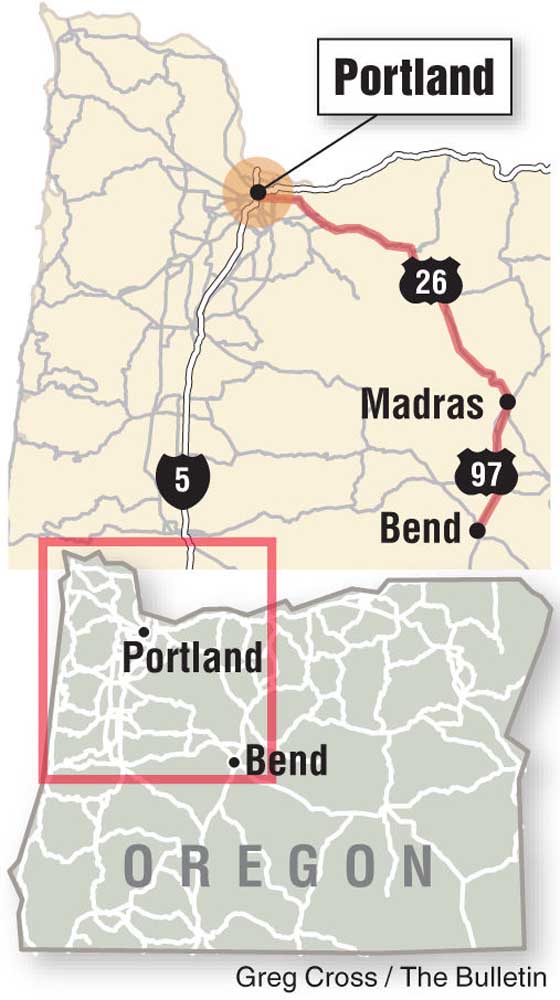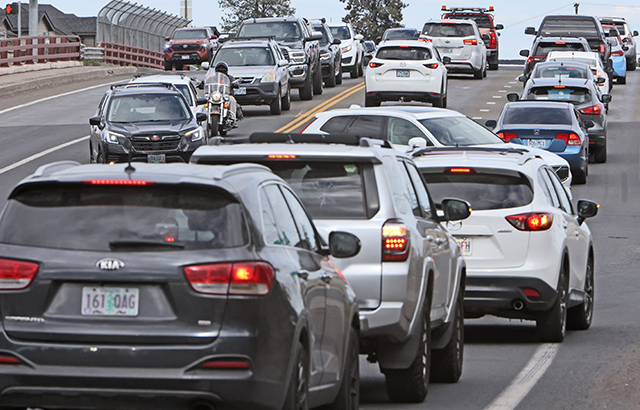Portland offers pedal-powered pot tour
Published 12:00 am Sunday, August 28, 2016

- Portland offers pedal-powered pot tour
PORTLAND —
The traditional promise that the early bird gets the worm doesn’t just apply to wildlife watchers.
Trending
Todd Roll, the owner and founder of downtown Portland’s Pedal Bike Tours, saw a new market emerge after Oregon legalized recreational marijuana use last year. Today, the company’s Pot Tour is one of its most popular.
The three-hour, 11-mile cycle begins at the company’s Old Town store, just south of Burnside Avenue. It proceeds through southeast Portland’s Hawthorne and Division Street neighborhoods with stops at dispensaries and head shops, rolls through rose gardens and makes a requisite munchies stop at the Salt & Straw ice cream shop.
Designed in large part by three-year employee Sarah Gilbert, this circuit is educational as well as recreational.
Gilbert’s narration includes a description of Portland’s extended history with hemp, which she said was a commercial crop in the Willamette Valley as far back as the 19th century. Legalization, she said, was preceded by the decriminalization of marijuana in the 1970s: Oregon’s state Legislature, led by Vera Katz, later speaker of the house and a three-term Portland mayor, was the first to do so.
A statue of Katz, who is still alive at age 93, sits beside Portland’s Eastbank Esplanade. It’s no coincidence that this bronze sculpture is the first stop on the Pot Tour, after a bicycle crossing of the Willamette River on the Steel Bridge.
More than Starbucks
Trending
Gilbert, my guide on this tour, sat beside Katz’s likeness as she described what I could expect during the next three hours on two wheels. We would be stopping at two dispensaries, she said, where employees would describe the types of herb available, and a pair of retail outlets selling drug-related paraphernalia such as pipes and literature.
Although absolutely no consumption of marijuana would be permitted in any shop or during the ride — driving under the influence extends beyond alcohol to any foreign substance — a post-tour sample would be offered later in the tour.
Retail sales of marijuana, I learned, are controlled by the Oregon Liquor Control Commission. Dispensaries may sell up to a quarter ounce of cannabis per adult, per day. Adults may carry 1 ounce of marijuana on their persons and keep as many as 8 ounces at home.
“There are about 120 shops in Portland,” Gilbert said, “and about 280 in Oregon. That’s more than the number of Starbucks Coffee shops, 248, or McDonald’s, 205.”
She led me first to Cannabliss, ensconced in Portland’s old Fire Station 23, a 1913 structure listed on the National Register of Historic Places. That it is the oldest dispensary in Portland (2011) is relative.
Cannabliss opened as a sort of “farmers market” for marijuana growers, a place where medical marijuana card holders could come to smoke until legalization in 2014, Gilbert said. With the beginning of recreational pot sales last October, the market shifted.
Retail associate Michael Murphy said the shop carries 45 varieties of pot with names as diverse as the colors on Joseph’s multicolored dream-coat. There’s Purple Haze and Blackberry Kush, Killer Queen and Lodi Dodi, Kryptonite and Skywalker and Tangerine Dream.
“We really don’t have any bad weed,” Murphy assured me. But he did offer some advice: “If you don’t like the smell, you’re probably not going to enjoy smoking it.”
The two main strains of marijuana, he said, are indica and sativa, with a hybrid choice that balances their effects. Indica, Murphy said, is good for relaxing; it can relieve muscle pain and contribute to a good night’s sleep. Sativa can help focus mental energy and stimulate the appetite.
CBD (cannabidiol, an anti-inflammatory compound) and THC (tetrahydrocannabinol, promoting euphoria) are the principal active ingredients among more than 80 identified in marijuana, he said. His personal favorite, Murphy said, is Trinity: “I strut down the street. I feel an inch off the ground.”
Munchies and buds
I was intoxicated not by fumes but by the sweet scent of summer roses as Gilbert and I pedaled through southeast Portland’s Ladd’s Addition. The streetcar-era neighborhood was developed at the start of the 20th century with a diagonal pattern distinct from the grid of the rest of the city. Four diamond-shaped hubs between 12th and 20th streets contain some of the Rose City’s most delightful floral displays outside of Washington Park.
We made a stop for munchies at the Division Street shop of Salt & Straw, Portland’s hippest ice cream shop, where flavors range from cinnamon snickerdoodle to roasted parsnip and banana sorbet.
Almost next door, we found Rip City Remedies, an intimate dispensary whose openly displayed stock of dried buds included the likes of Blue City Diesel and Blue Magoo, Gorilla Glue and Dr. Who. Each individual stack was exhibited with its THC and CBD quotients posted, giving patrons information on their potential benefits and effects.
As at Cannabliss, we were asked to provide identification in a reception parlor before entering the sales room. Signs in English and Spanish reminded us that there would be “No On-Site Consumption of Marijuana.”
From Division Street, we pedaled to Hawthorne Boulevard, long a center of activity for Portland’s counterculture. At the Third Eye Shoppe, a fixture here since 1987, we perused a volume written by the store’s late founder, Jack Herer, that claims to be “the #1 best-selling hemp book of all time!”
“The Emperor Wears No Clothes” (sold here for $24.95) promotes Herer’s claim that marijuana is the “only one known annually renewable natural resource that is capable of providing the overall majority of the world’s paper and textiles; meet all of the world’s transportation, industrial and home energy needs, while simultaneously reducing pollution, rebuilding the soil and cleaning the atmosphere.”
Today, Third Eye is owned and operated by Herer’s son, Mark Herer. Its inventory ranges across clothing, crystals, jewelry, incense, black-light posters and hippie-style gifts on its first floor; the upper level displays glass pipes, water pipes, hookahs, vaporizers and other smoking apparatuses.
Almost across the street, Mellow Mood is like an art gallery for marijuana connoisseurs. Fantastical art-glass pipes, many of them priced in the thousands of dollars, are carefully locked into glass display cases from which multicolored gargoyles, redesigned as smoking paraphernalia, peer at fascinated shoppers. My favorite was a translucent trumpet whose three finger valves were said to enable a smoker to control the flow of vapors.
Numerous tours
Returning back across the Willamette to Pedal Bike Tours’ head office, I asked Roll about other guided urban explorations offered by Pedal Bike Tours.
The most popular tour, Roll said, is the Historic Downtown Tour ($59). Without crossing the river, this includes everything from Pioneer Courthouse Square to the Portland Art Museum, Powell’s Books to the Lan Su Chinese Garden, including extensive narration.
At the same price point ($69) as the Pot Tour are the Oregon Brewery Trail and the Food Cart Crawl. The first includes visits to several microbreweries; the second takes in several of the city’s most popular foodie trucks. Both are easy rides of less than 8 miles.
For visitors with a desire to get beyond the Portland city limits, the company offers tours of the Columbia Gorge and the Oregon Wine Country, both at $99. The 9-mile Gorge tour includes six waterfalls — highlighted by Multnomah Falls, tallest in the Northwest — and some easy hiking. The 10-mile wine lovers’ frolic covers several Yamhill County wineries in the greater McMinnville area, well known for its outstanding pinot noirs.
A seasonal Oregon Coast itinerary is also available, and Pedal Bike Tours has an additional office in Honolulu from which tours explore the Hawaiian island of O’ahu.
Rentals are available for self-motivated cyclists: $8 for one hour, $24 for four hours, $35 for a full day.
Portland by bike
It would be difficult to find a more bike-friendly city than Portland. The U.S. Census Bureau reported in 2014 that Portland had by far the highest percentage of bicycle commuters of any large city in the country: 7.2 percent, twice what it had been just 10 years earlier, and 12 times the national average of 0.6 percent.
While many residents of Bend and Redmond use a bicycle as their primary form of commute transportation, they don’t face the same daily challenges of bumper-to-bumper, big-city traffic as Portland bike commuters. Nor must they deal with drawbridges or drafts from semitrucks while crossing the dozen-odd Willamette River bridges that connect downtown Portland with its heavily populated east-side neighborhoods.
But Portland is on top of this challenge. Back in 1996, when more than 2,000 riders already were crossing the downtown bridges every day, the Portland City Council adopted a formal master plan to guide the urban bicycling future. Since that time, the city has more than doubled its network of paved bikeways to more than 300 miles, installed thousands of bicycle racks around the urban area, and created a Safe Routes to School program for young riders.
By 2008, the city estimated that more than 16,000 bicyclists were crossing the bridges daily. Bicycle retail and repair shops, and other related businesses, had burgeoned more rapidly than anyone might have expected in a city as rainy as Portland. Almost every day, some business or organization is sponsoring group rides, events or activities.
A revamped Portland Bicycle Plan for 2030 calls for 930 miles of low-stress, higher capacity bikeways, as well as improved bicycle parking and greater accommodation for bikes aboard mass-transit vehicles. The plan envisions Portland as “the hub of a connected regional bicycle network (where) more than a quarter of all trips are made on bicycles.”
An early step in that direction was the new Tilikum Crossing Bridge, which opened in 2014. It extends into southeast Portland from the downtown South Waterfront district, giving bicyclists a new commute option on a bridge built not for private vehicles, but for light-rail and other mass-transit traffic.
Portland’s public-transportation system, TriMet, does not charge an additional fare for riders who take their bicycles on buses, downtown trams or suburban railways. In fact, the system encourages riders by providing bike hooks within its vehicles, as well as storage lockers and hundreds of additional bike racks at many of its stations and transit centers.
And on July 19 of this year, Portland debuted an urban bike-share program with a $10 million sponsorship grant from Nike. Biketown initially provides 1,000 bikes at various stations around the city, available for rental with the swipe of a credit card.
— Reporter: janderson@bendbulletin.com








